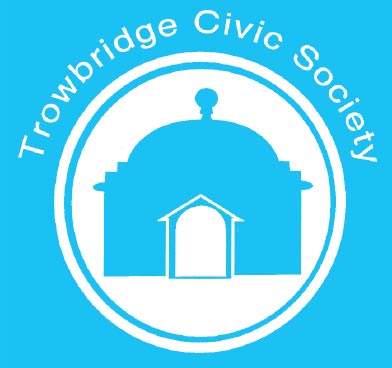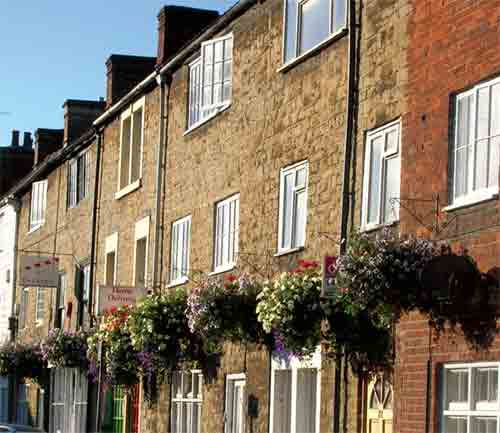| ||||||||||||||||||||||||||
Contents
Click on the item to go to the article. |
Editorial CommentTrowbridge in Bloom this year has been a glorious success and has helped push the country's economic woes off the agenda.
Copy deadline for the spring newsletter is Tuesday 18 January 2011, letters and articles are most welcome. |
Forthcoming Events
| 2010 | ||
| Tuesday 19th October 2010 19:30 |
Some Wiltshire Place Names Talk by Martyn Whittock |
Haden Room, United Church, Church Street, Trowbridge. |
| Tuesday 16th November 2010 19:30 |
PUBLIC LECTURE Trowbridge Scrapbook (Part 2) by Andrew Jones |
Haden Room, United Church, Church Street, Trowbridge. |
| 2011 | ||
| Tuesday 18th January 2011 19:30 |
New Year Social and Quiz – Please bring a plate of food – Drink provided. Subs for 2011 may be paid this evening. |
Haden Room, United Church, Church Street, Trowbridge. |
| Tuesday 15th March 2011 19:15 |
Annual General Meeting followed by a talk – Studley Green
Project and Going To Blazes (Part 2) by Mr. John Craig QFSM |
Haden Room, United Church, Church Street, Trowbridge. |
To arrange for a lift or to volunteer to car share please contact Glyn on 755784
From the Chairman
Some of our keen eyed members spotted a very negative article about Trowbridge by Charles Moore in The Spectator at the end of July. The title on the front cover, ‘Why is Trowbridge so soulless?’ was definitely not flattering. Charles Moore wrote this after stopping in Trowbridge to buy a sandwich.
Among the things he complained about were the town's road system and the lack of independent traders. He described The Shires as an ‘appalling shopping precinct’ and talked about ‘the demeanour of the tattooed people shuffling around’. He concluded by saying there was a lack of pride in the town and that ‘Trowbridge could be ten times better if it tried’. As you might imagine this drew a swift response. I wrote on behalf of the Society, Trevor Heaks, our town crier also wrote in support of
Trowbridge as did Ken Rogers our president and Andrew Murrison our MP. The Wiltshire Times also took up the cause and published an article about it on August 6th. In his letter Ken invited Charles Moore to make a more leisurely visit so that he could be shown round our town. The Old Etonian has apologised and plans to make a return visit. He said ‘I bear no ill will to the town of Trowbridge at all. I am glad to hear people are proud of their town’.
You may be pleased to hear that the County Council Cabinet approved the handing over of the former Margaret Stancomb building to the Wiltshire Rural Music School on a peppercorn lease. This will ensure a community use for the building for many years to come and the Conservation Area ‘landmark building’ will be preserved and continue to enhance the street scene in British Row.
It is so good to see at last some of the gaps in the town being filled. I am referring to the new build between Timbrell Street and British Row. This, together with the block of land at the top of the Conigre, York Buildings and the land in Saint Thomas's Passage, were all part of the northern section of the Inner Relief road route and have remained vacant for over thirty years. The remaining three plots will eventually be filled with much needed housing. The new build looks as if it is going to be a really interesting development with much attention paid to detail. I await with interest the removal of the scaffolding, and one can only hope that the other three sites will be treated similarly.
Planning Matters
The downturn in the economy is continuing to affect the number of planning applications. No major schemes have been put forward in the last 4 months, but listed buildings do need regular care and attention. The Kings Arms in Castle Street have consent to reinstate a chimney and fit a conservatory roof light. Nonsuch House at the end of The Parade (6 Wicker Hill), want to remove an unstable chimney, and Courtfield House needs attention to the front boundary wall and structural timber under the loggia. St James's Church seeks consent to replace stolen lead on parts of its roof.
Tomlinssons have resubmitted their plans for the Rose and Crown, Stallard Street, and our objections still apply. Manor Farm House, Westbury Road, North Bradley, have permission to tackle the unused buildings within the curtilage of their listed building. Newtown School have consent to upgrade their swimming pool and changing facilities.
Interestingly the housing elements in the Sainsbury's site will have solar panels to increase their energy efficiency. The 2005 application to redevelop the current Trowbridge Rugby Club site is now approved for housing and supporting services. However the bottom has dropped out of the new build housing market, it may be a long time before this goes ahead.
An Apology
In the last newsletter I not only gave Jackie Dowell the wrong name but also wrongly attributed her excellent piece on the Sensory Garden. Incidentally although not abundant with blossom there were some splendid flowers on the Tulip Tree this summer. Congratulations to Jackie and her team for maintaining this marvellous amenity. JA
Heritage Open Days - 2010
Organising Heritage Open Days locally is time consuming, I often wonder why I do it. However I meet people fascinated by our built heritage, by the links with social and political aspects of history and gaining a dawning realisation that Trowbridge is a special place. That is when I know that I will do it all again at least one more year.
Undoubtedly the highlight this year was 66/67 Fore Street, known as Director's House when used by Ushers. Those who visited it briefly as one of Pevsner's Palaces on Thursday's walk, were among the 125 visitors on Saturday. All were fascinated by the colourful fanlight, the amazing ceilings, the workmanship on the Tudor beams and the windows that are not windows! Links between Seymour estate road names and the young Elizabethan, Mary Langford, whose great granddaughters were both Queens of England in their own right (Mary II, who ruled with William III, formerly William of Orange, and Good Queen Anne, the last Stuart monarch), interested local residents and those from further afield.
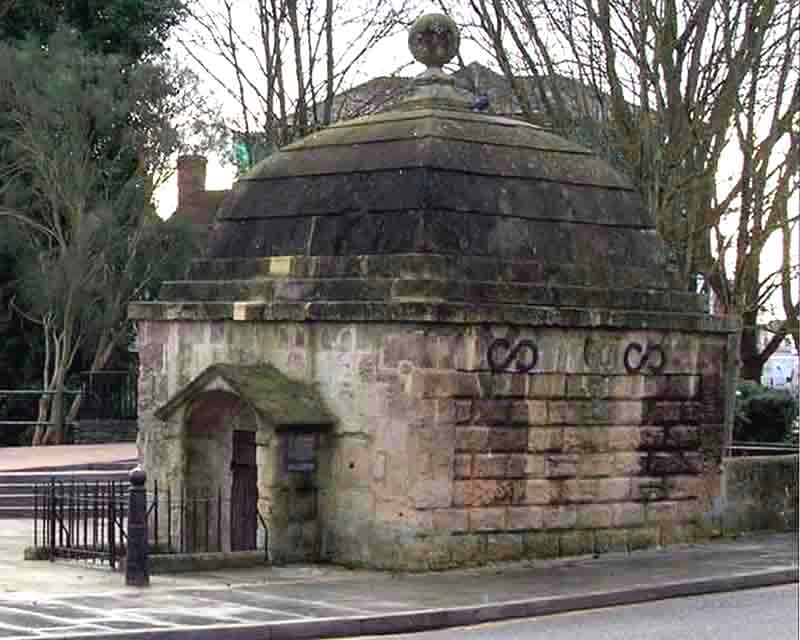 As always the most popular venue was the Blind House with 192 visitors. Young people particularly reacted with giggles or slightly bawdy humour when looking at the primitive toilet facilities.
As always the most popular venue was the Blind House with 192 visitors. Young people particularly reacted with giggles or slightly bawdy humour when looking at the primitive toilet facilities.
Did you know that local citizens used to drink at The Blunderbuss? Ken Rogers showed us photographs and drawings of long defunct drinking places. Sadly few people were at the Museum to hear an excellent talk on Fashion through the Ages by Susie Ralph, and even less visited the Cricket Pavilion to look at memorabilia about famous visiting cricketers, such as W G Grace, ‘Beefy’ and Viv Richards. However when I called in at the Masonic Hall that was buzzing with visitors, asking lots of questions. One visitor's interest in St Thomas's Church lasted an hour! His Worship the Mayor with his two daughters were among the 27 intrepid climbers of the stone spiral staircase to investigate St James's bell tower on Sunday. After descending, everyone of them were extremely enthusiastic, quite unable to stop talking about the experience.
The Trowbridge Museum - 20 years young
On Saturday 8th August this anniversary was celebrated with a very well attended lunchtime buffet. The mayor gave a most supportive address, the Friends produced a glossy souvenir edition newsletter and many took the opportunity to have another look at John Sansom’s splendid photographic exhibition.
Singer's Foundry
During our visit to Frome in April Singers was mentioned. It produced many famous bronzes as well as
Trowbridge’s war memorial figure. The firm relocated but fell on hard times so it pleasing to learn that
ex-banker Nasser Azam has bought the assets of Morris Singer, based in Essex, and intends to revive the
tradition of monumental sculpture. This was reported in The Times on 15 June 2010.
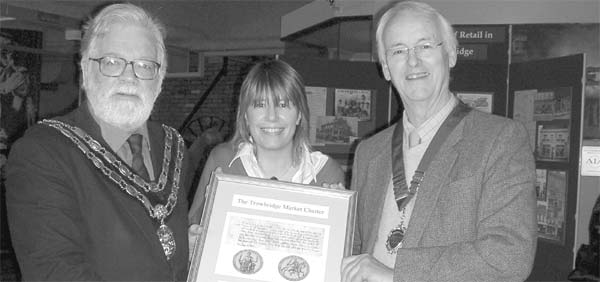 A copy of the Market Charter (see Newsletter Autumn 2009) being presented to the Town Council represented by the then mayor,
Jeff Osborn at The Trowbridge Museum where it is to be displayed
A copy of the Market Charter (see Newsletter Autumn 2009) being presented to the Town Council represented by the then mayor,
Jeff Osborn at The Trowbridge Museum where it is to be displayed
In the Swim
In 2001 David Mattock produced a most comprehensive illustrated 100 page document: THE HISTORY OF THE TROWBRIDGE BATHING PLACE IN THE RIVER BISS AT COWLEAZE AND THE PROVISION OF A SWIMMING POOL, BATHS AND WASH HOUSES. Given the current disgraceful attempts by many local authorities to close yet more swimming pools, 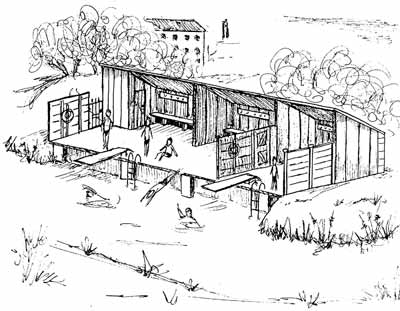 it is interesting to learn of the struggles endured in the years prior to the opening of our first bathing place in July 1879. David was unable to find any photographs but it is shown as an artist’s impression by Mervyn Grist on the cover.
it is interesting to learn of the struggles endured in the years prior to the opening of our first bathing place in July 1879. David was unable to find any photographs but it is shown as an artist’s impression by Mervyn Grist on the cover.
150 yards of the river was available with depths from 4 to 9 feet. The bathing shed (81 x 9 feet) was divided; two thirds for the public and one third for subscribers, with each section having a springboard and a ladder – all for the cost of less than £130. Most of us locals remember several of the older generations (men and boys only) who swam there until it was demolished to coincide with the opening on Saturday 13 May 1939 of our wonderful art deco pool in Brown Street (cost £8000). My mother attended the event as a guest of her councillor father in law, Albert William Austin - his wife refused to go! This pool was demolished to make way for the current Tesco store.
For years prior to 1879 the wrangling over the cost and siting of the proposed bathing place is reported in committee minutes which are in places hilarious. At one time the proposal was for a site close to Ashton Mill – near the ‘Tesco’ footbridge. However the proprietors of Messrs Palmer and Mackay objected: ‘The firm said it would be overlooked by the mill, and women would be subjected to sights such as ought not to be brought before them’. The place eventually settled on, and given at a nominal rent by the Longs of Steeple Ashton, was further upstream, near the little waterfall/rapids introduced during the development of Biss Meadows Country Park.
David Mattock's book would be well worth publishing for a wider audience and it is a pity that it is only available through the copies lodged at the Trowbridge Museum and the Record Office in Chippenham.
The Stallards reopening
As previewed in the Wiltshire Times, this historic pub (see Newsletter spring 2009) reopened at 6.15pm on Friday 31 July and it was a really joyous occasion. A friend and I enjoyed some excellent beer (Milk Street brewery, Frome), good company from all walks of life and a friendly ambience.
The conversation was so animated that the background music was unnecessary and the four large doormen seemed a bit over the top - but then we left about 8.30pm.The building has been tastefully refurbished with many original features retained, including the attractive bar counter and its ornate front. Go and try it - arguably the only proper pub in town. JA
Sainsbury's old and new
In this edition of the newsletter we have articles on two Sainsbury’s. Glyn gives us his opinion of the design of the new store on the Ushers site and Mrs Patience Morris (née Sainsbury) tells of her family history as a member of the Trowbridge family of grocers and corn mill owners. It is a nice coincidence that the original Trowbridge Sainsbury's shop was in the Conigre and the new store is in what is now known as Conigre Square.
A pleasing feature of the new store are the ‘sun tubes’ which are fitted in the ceiling. These allow natural light into the all parts of the store by a system of tubes and mirrors making the space feel light and airy. Another bonus is that one no longer has to drive to Bradford-on-Avon or Melksham to shop at Sainsbury's. Hopefully the newly planted trees will grow and provide a much needed screen for the site! KA
The Miller's Daughter
This was first published in 2001 by the Bath Chronicle as a competition entry. Following the opening of the ‘other’ Sainsbury’s in the summer and Stanley Jones's letter in the Wiltshire Times reminding us all of the ‘original’ we were delighted to learn of Patience's article, which was brought to our notice by Mrs Joan Iles. Eds
I was born on May 25th 1927 at Innox House, Innox Road, Trowbridge, the third and only surviving daughter of George and Ivy Sainsbury. I had a happy childhood with devoted parents, happy - at last - to have a living child. Innox Road was a lovely place to grow up. We children could all play with our bikes around the back of Innox and Bradford Roads in perfect safety and the sun always shone!
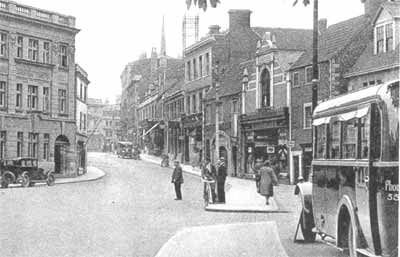 One of my early memories is of running through the Innox to meet my father on his way back from opening up the gates of the family mill at Wicker Hill at 7am in the morning.
One of my early memories is of running through the Innox to meet my father on his way back from opening up the gates of the family mill at Wicker Hill at 7am in the morning.
The family business was started by my great grandmother, Anne Sainsbury. She opened a small grocery shop in her house at Broad Street, the Conigre, in 1871.
With increasing family - she eventually had six sons and four daughters - she found it difficult to cope, so her husband, John Stephen, left the gas works, where he was working for his brother Richard Henry Sainsbury, who was the manager.
The family moved to 4 Hill Street in 1879 where, to meet expansion needs, he bought the house opposite and the adjoining building known as the Victoria Hall. In 1894 John bought Webb’s cloth mill in Wicker Hill and adjoining land which was used for the mill, corn stores and grocery shop which was built in 1903.
On 2nd February 1904, John took into partnership, his sons, Henry (Harry), Robert (Rob), Samuel (Sam) and his wife's stepbrother, Edward Payne. His second son Nelson, joined the business after the first world war but was happy to work behind the scenes in the mill office keeping a low profile and smoking his pipe! John's other two sons, John and Arthur, emigrated to Australia and were not connected to the business. Of their four daughters, only Gertrude had children, two sons and one daughter. Margaret married but died, aged 26, from consumption. Lilian and Violet did not marry.
The business prospered! Harry and Sam were entirely concerned with the milling and animal feed side and Rob and Edward Payne with the expanding grocery side. As well as Bridge Mill there were at one time, branches at Calne, Chippenham, Tisbury, Wick, Avomouth and Salisbury where there was also a wholesale grocery business. The main retail shop was at 3 Wicker Hill with two branches in Trowbridge and one at Bradford-on-Avon.
Edward Payne died in 1930, the same year as founder John (who never really retired). Robert died in 1934. As there
were no family really interested in the grocery side of the business a manager was appointed from outside the family.
George, Harry's only son, joined the business in 1919. He served with the 2/15 Civil Service Rifles in the first world
war and was a stretcher bearer at Vimy Ridge. By the 1930's he was becoming prominent in the corn trade.
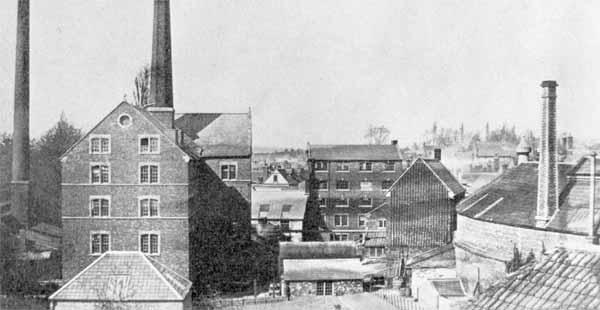
After founder John died in 1930, a private company was formed, H R & S Sainsbury Ltd. Sam's son, John Lessiter, now joined the firm. Sam was chairman until a few years before his death in 1949. George then became chairman, a position he held at his death in April 1961.
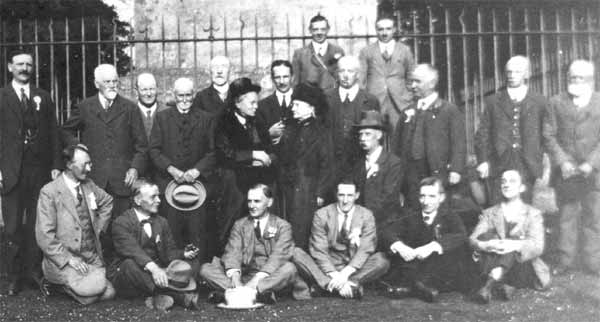 |
| Outing of the Trowbridge Grocery Association 1926 Back Row: Giddings, Slade, Chedney, John Sainsbury, Porter, Mrs Sainsbury, Frank Wooten, Mrs Wooten, Pritchard jn, Evans, Hamaton, Payne, Pritchard sn, W Rose. Front Row: Fare, Nicholls, (BOA) Robert Sainsbury, Coupland (BOA) Smith, Gover, H Rose |
With the coming of the supermarkets the grocery shops were gradually closed down as uneconomic. The Wicker Hill shop was leased to another grocer for a while in the early 1960's.
In the mid 30’s my father sometimes dropped myself and a friend at the corn stores on a Saturday afternoon whilst he went to watch Trowbridge Town playing football at Frome Road. We would be allowed to play in the corn bins with brown paper bags and little scoops - playing shops - I can smell the corn to this day!
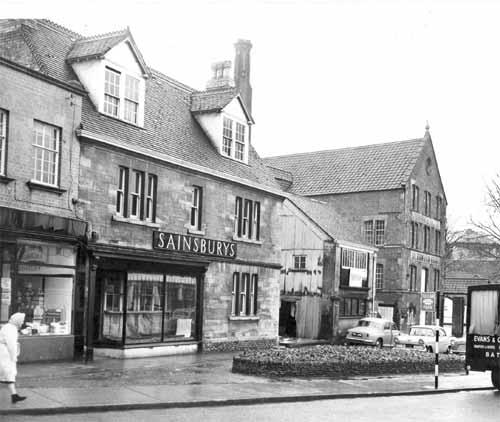 In September my mother and I would watch the Saturday evening carnival procession from the office window as it came across the town bridge and up Wicker Hill. My father was the commentator from the hospital float which was sometimes a pirate ship and sometimes a flower basket. He had a megaphone to prise as much money as possible from the spectators. As he knew everyone in
every business in Trowbridge, huge sums were raised - and Sainsbury's got the loudest pleas for cash as the procession
went by!
In September my mother and I would watch the Saturday evening carnival procession from the office window as it came across the town bridge and up Wicker Hill. My father was the commentator from the hospital float which was sometimes a pirate ship and sometimes a flower basket. He had a megaphone to prise as much money as possible from the spectators. As he knew everyone in
every business in Trowbridge, huge sums were raised - and Sainsbury's got the loudest pleas for cash as the procession
went by!
In 1968 a new state-of-the-art mill was built at Ladydown and opened in 1969 but with no Sainsbury left to run it (John Lessiter Sainsbury had retired through ill health in 1970) the remaining family decided to sell the business in 1973.
It was sad to see Bridge Mills pulled down. I am sure conservationists would not have let it happen today. I’m glad it did not happen in my father's time, it would have broken his heart.
The Conigre
Once again it would appear that Trowbridge has another third rate building development. Now that the Sainsbury's
flats, attached like a carbuncle to the store are almost complete we can see how none of this development is worthy
of this very prominent position in the town. Why is it that we are lumbered with such an awful building? I lay the blame
at the feet of the Wiltshire County Council planning department. These are the professionals who look at the plans
on our behalf and recommend them for approval or refusal. I wonder sometimes if they have ever had any input in
aesthetics during their training. This development may meet all the criteria for building regulations etc, but did they
not see that the flats would look like an after thought, a block that bears no relation to the building to which it is
attached or to any of the listed buildings opposite? You only need to drive around The Conigre to see what I mean.
The block itself has nothing to commend it with its prominent plastic windows and white iron balconies. It must
be quite sickening for the owners of the listed properties opposite when planners insist that they install wooden
windows and yet they have to look across at this ghastly plastic facade.
I can think of nothing at all to commend these flats and the same applies to the supermarket. I think it must take the prize for the ugliest, most bland supermarket building in the country with its flat roofs, vast expanses of plain cream walls and pink brick that reflects nothing of the listed buildings on British Row. Apparently the brick was matched to the replacement brick of the unlisted Ushers Office building and not to the listed Westcroft House or the Conigre Parsonage next door. In a letter to Lance Allen, the Town Clerk, the planners said ‘The Trowbridge red brick is a very flat engineering brick of uniform red colour’. A quite incredible statement given that Trowbridge brick, a deep, warm orange colour, was all handmade. Have none of the planners ever stopped to look at the buildings in Timbrell Street, Castle Street or Newtown? There are so many others and they don't appear to have noticed that the Ushers Brewery facade is of engineering brick with ashlar dressings. Sainsbury's and our planners should hang their heads in shame as this development next to a Conservation Area is a disgrace.
The only good thing I can say about it is that it has provided very welcome employment opportunities for local people.
Book Review:
200 Years of Retailing in Trowbridge by Roger F Newman 2009
The relatively simple title of Mr Newman's survey belies its scope and complexity. It contains an almost incredible amount of detail of the history of buying and selling in Trowbridge. There is a short bibliography and a list of acknowledgements but these cannot hide the sheer amount of observation, enquiry and background information necessary to assemble this history. How Mr Newman has chosen to present his information is displayed in the list of contents. He first moves from the physical evolution of shops to the provisions made for delivery to customers. The latter half of the book is divided into ‘Trades of Yesterday’ and ‘Trades of Today’. There are, of course, retailers who span most of the period covered. There is a good deal of social history implicit in the account; for example, the extremely long hours, sometimes until 9pm, presumably to accommodate the town's textile workers. The booklet is fully illustrated with historic bill heads and modern photographs to display the development of various retail outlets. But it is as history that it should be valued, charting as it does the changes, perils and benefits of those engaged in trade and their effect on the town.
(Roger Newman's book is available from the Trowbridge Museum shop - Eds)
| Trowbridge History Volume 5. |
| The latest in this series edited by Ken Rogers is now on sale at the museum shop. It contains articles on Ernest Hendy, Wyke House and the Bythesea family, Billy George - footballer, coalition government, wool washing, 45/46 Fore Street, Hilsers shop, canal travel and the Rood Ashton Hall locomotive. |
Millstones
On a Museum Friends outing to Mells, our guide Dereck Hunt showed us some half millstones used as a wall coping. What appear to be fragments of millstones top the garden wall of the house next to David Perkins's shop in Frome Road. EDS
Naming New Streets
The County Council had a policy of not naming new streets, roads etc after ‘any persons living or dead’. Wiltshire Council reviewed this in June (after receiving the views of the town council and the Society) and it appears the policy has been modified (initially for an interim 6 months) and probably names of some fairly long time deceased will be considered! EDS
Green Lane Wood Reserve
Green Lane Wood is one of 36 reserves comprising the Wiltshire Wildlife Trust estate. It is some 1¼ miles from Trowbridge town centre and is located between Green Lane, an ancient bridleway and the A350. There is pedestrian access from Green Lane and a small car park off the very fast A350 to the east. The woodland part of the reserve is 39.2 hectares in area and is adjoined to the NW by a 1.1 hectare unimproved grassland meadow.
Recorded in Domesday Book, Green Lane Wood was originally part of the Forest of Selwood. Between the Dissolution and 1630 when it was sold to the Long family it belonged to the Crown. In 1930 the Rood Ashton estate of the Long family was sold. The wood was subsequently owned and lived in by an eccentric recluse, Mrs Annie Aslachsen, who on her death bequeathed it to the Trust. Thus it was in 1990 the Trust took ownership of the wood. The meadow was added to the reserve in 1998. The wood is open to the public at all times and is well used.
Pedunculate oak is abundant throughout the wood. Field maple is also widespread and ash regeneration can be vigorous in a number of recently worked areas. Alder is common in damper areas and birch, aspen, elm and Crab apple are also to be found. Old rides have been opened up and a network of permissive paths has been created and maintained. Two electricity power lines pass through the wood. Obligatory management of the wayleaves ensures open ground and scrub, creating new and diverse habitats which more than compensate for some visual unsightliness. These more open areas are particularly beneficial to butterflies and wildflowers.
No woodland management had taken place between a major tree felling on the sale of the wood in 1930 and the Trust's acquisition in 1990. The wood had grown very dark and dank in the intervening years and was in desperate need of opening up to admit much more light. This would greatly benefit the flora and fauna. After several years of preliminary work the Trust created the Green Lane Wood Supporter Group, a band of volunteers who would carry out the large majority of the work of re-invigorating and enhancing the wood. To this end the wood was divided into two sections. The larger three fifths designated non-intervention. The only work to be carried out here is that necessary for public safety. The smaller section would be worked as it would have been historically, the main task being to thin out trees that had self-seeded or become too drawn over the years, with the aim of selecting the best oaks to become forest standards and to re-instate the hazel coppice regime. Felled timber is cut to length, stacked at the ride sides and sold as fuel. Hazel is also sold as needed.
On a typical early spring visit one would see a splendid display of primroses throughout the wood, followed by bluebells,
dotted with white stitchwort and pink herb robert. There would also be a good showing of wood anemones.
Next come the orchids, early purple, spotted, a few pyramidal and twayblade. Further into early summer the
greater butterfly orchid appears. A special feature in a quiet part of the wood is a display of violet helleborine. As
autumn develops so do the many berries and hazel nuts; guelder roses and spindles too put on bright shows of colour
and the leaves on the high trees colour up, especially the field maples. Winter brings its own beauty with stark tree
outlines often sparkling with frost and sometimes snow laden. So there is much to be seen in all seasons. The story
can equally be repeated for butterflies, moths, birds and fungi.
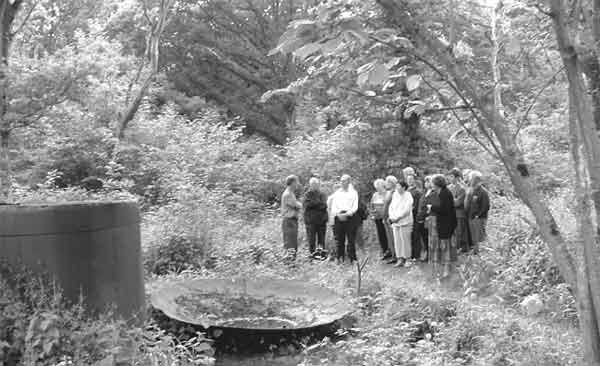
Society members on guided walk in Green Lane Wood stopping by the charcoal burner which is now overgrown
All the work in the wood is carried out in accordance with a professionally prepared management plan agreed with the Forestry Commission and under the overall direction of the Trust's Reserves Officer. Week by week work is led by two voluntary wardens, Peter Lindsey and me, supported by a large team of volunteers. These meet twice weekly on weekdays and monthly on the first and last Sundays, from September to the end of April. A further group of volunteers with specialist knowledge regularly visit the wood at times appropriate to their speciality to monitor systematically birds, butterflies, moths, wild flowers and fungi. They all keep meticulous records. At any one time as many as two dozen volunteers may be involved. Since the volunteer groups were set up almost two hundred people have been involved, some for short periods, others from the beginning and continuing. Although the volunteers are drawn from round and about many, including both voluntary wardens, live in Trowbridge.
Green Lane Wood Reserve is a wonderful amenity for the residents of Trowbridge, providing scope both for those who simply enjoy a walk in pleasant surroundings and for those with a greater interest in delving into and studying the natural world on their doorstep. With the natural world under such pressure these days, through the ownership of Wiltshire Wildlife Trust, it provides an enduring environment that will grow in value and importance for local people in the years ahead.
RECENT MEETINGS |
Guided Walk Around Trowbridge 20th May
On a beautiful warm evening Glyn Bridges, armed with the Society's new PA system, welcomed our guests from the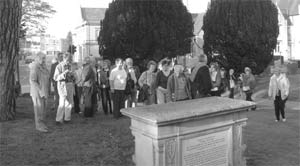 Midsomer Norton Society as we assembled around Hilliker’s tomb in St James’s churchyard. The joint group of almost 50 then spent time in the church (kindly opened for us by the churchwarden) and then perambulated the town, taking in most of the major town houses, a wide selection of industrial buildings, the park and the Blind House. Refreshments (courtesy of the committee) were served at the United Church. It was very obvious from casual conversations and Paul Myers ‘thank you’ speech that our visitors had been thoroughly impressed by the town's architecture and had very much enjoyed their visit.
Midsomer Norton Society as we assembled around Hilliker’s tomb in St James’s churchyard. The joint group of almost 50 then spent time in the church (kindly opened for us by the churchwarden) and then perambulated the town, taking in most of the major town houses, a wide selection of industrial buildings, the park and the Blind House. Refreshments (courtesy of the committee) were served at the United Church. It was very obvious from casual conversations and Paul Myers ‘thank you’ speech that our visitors had been thoroughly impressed by the town's architecture and had very much enjoyed their visit.
Where we were on Saturday July 10th
Well I will tell you, we were in a lovely garden sitting under gazebos, which not only shaded us but also the goodies which had been made and donated for sale. Sponge cakes, fruit scones, Welsh scones (wonderful and very morish), and not forgetting the famous lemon drizzle cake (a committee member's speciality) that was snapped up before it had time to settle on the stall. There was also an excellent bring and buy stall which had lots of things you never knew you wanted, that is of course until you saw them.
The book stall also had a fine and varied array of titles, the pièce de résistance were facsimile copies of the Trowbridge Chronicle for Saturday July 15th 1889. This included a report of ‘the opening of the Jubilee Town Hall by HRH the Duchess of Albany’ among other gems, but we had no time to read them at the time, as there was so much happy chatter going on between the visitors and members of the society, whilst drinking the excellent coffee made by Ruth Bridges and Anne Andrews.
As usual we had a very well supported raffle and our thanks are due to all those who generously donated prizes. No visit is complete without a tour of the garden and the interesting things you can see. Near to the gazebos a fig tree bearing very healthy figs, further into the garden were walnut, mulberry, damson, apple and plum trees all looking very fruitful. The soft fruit were well caged, a wise precaution as birds are encouraged to visit the garden.
Oh! I was so carried away with my memories of that pleasant morning that I almost forgot to tell you where we were. Our thanks must go to John and Kay Austin for their hospitality and sharing with us their beautiful garden in St Thomas's Road. This was a very successful event, raised about £120 and I’m sure thoroughly enjoyed by all present. Here's to the next coffee morning wherever that may be.
Society Outing to the Houses of Parliament 1st June
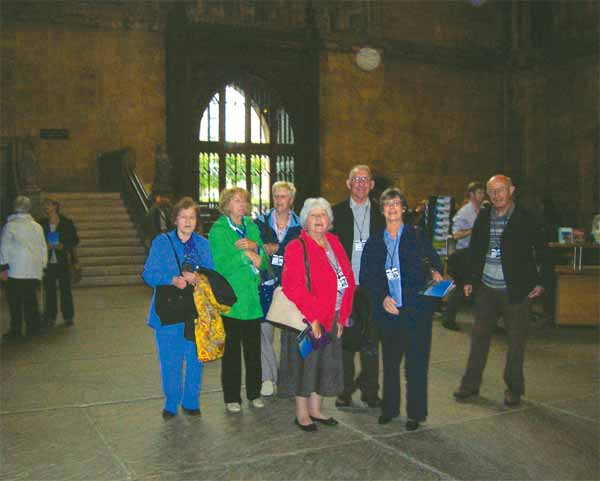 An early start saw 48 members gather at the Civic Hall at 7.15am. The coach left promptly and after stopping for coffee at Reading services, we disembarked in Westminster right outside the Houses of Parliament. Due to the size of the party we were divided into 3 groups and assembled in Westminster Hall to await our guide - the first group starting at 11.15. We had time to admire this amazing hall, built by William Rufus in 1099 it has the largest single span medieval timber roof in Northern Europe. Being the Tuesday following the Spring Bank Holiday the House was not sitting and we could visit both chambers, the Queen's Robing Room, stand at the despatch box, go through the lobbies and really get to know all the places that we have seen on TV. The tours were over by 1pm and we had free time until 5pm. There is plenty to see in the Westminster area, some sampled the food in the Jubilee Cafe in the Houses of Parliament and others adjourned to various museums and galleries. It was quite a surprise to bump into fellow society members in the National Portrait Gallery and then others in the cafe - we are obviously a very like-minded society! At 5pm our coach arrived on time and we were home in Trowbridge by 7.30pm.
An early start saw 48 members gather at the Civic Hall at 7.15am. The coach left promptly and after stopping for coffee at Reading services, we disembarked in Westminster right outside the Houses of Parliament. Due to the size of the party we were divided into 3 groups and assembled in Westminster Hall to await our guide - the first group starting at 11.15. We had time to admire this amazing hall, built by William Rufus in 1099 it has the largest single span medieval timber roof in Northern Europe. Being the Tuesday following the Spring Bank Holiday the House was not sitting and we could visit both chambers, the Queen's Robing Room, stand at the despatch box, go through the lobbies and really get to know all the places that we have seen on TV. The tours were over by 1pm and we had free time until 5pm. There is plenty to see in the Westminster area, some sampled the food in the Jubilee Cafe in the Houses of Parliament and others adjourned to various museums and galleries. It was quite a surprise to bump into fellow society members in the National Portrait Gallery and then others in the cafe - we are obviously a very like-minded society! At 5pm our coach arrived on time and we were home in Trowbridge by 7.30pm.
We had a most informative and interesting day and the organisation was like clockwork. Our thanks are due to Celia Russell for setting up the trip and to Andrew Murrison MP for sponsoring us and to our Chandlers' driver.
| Coleman's Family Dental Practice, Timbrell Street | The Trowbridge Museum |
| Janet Carpenter, Dr & Mrs Eames, Mr & Mrs Hateley, Mr & Mrs John Knight |
A walk around Wellow 11th June
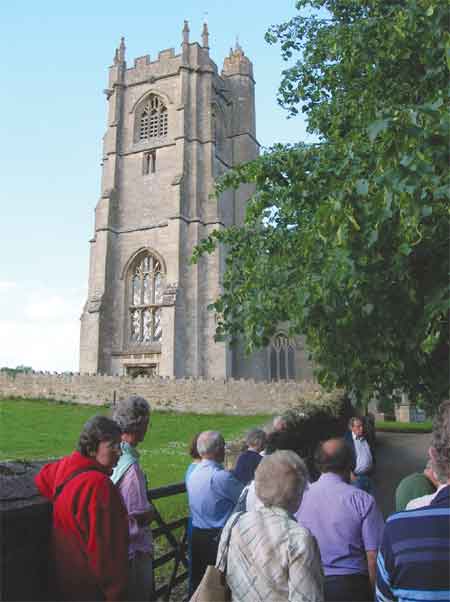 On a balmy evening to the accompaniment of swifts and swallows overhead, we met at the Church, which is dedicated to Saint Julian. The building is in the perpendicular style and its size reflects that it catered not only for Wellow but also the outlying Twinhoe, Baggridge and White Ox Mead. The present ediface, replacing one of Norman vintage, was constructed around 1370 while Sir Thomas Hungerford was Lord of the Manor. He was the first recognised Speaker of the House of Commons and a member of the family who occupied Farleigh Castle for around three hundred years.
On a balmy evening to the accompaniment of swifts and swallows overhead, we met at the Church, which is dedicated to Saint Julian. The building is in the perpendicular style and its size reflects that it catered not only for Wellow but also the outlying Twinhoe, Baggridge and White Ox Mead. The present ediface, replacing one of Norman vintage, was constructed around 1370 while Sir Thomas Hungerford was Lord of the Manor. He was the first recognised Speaker of the House of Commons and a member of the family who occupied Farleigh Castle for around three hundred years.
During the tenure of his son Sir Walter much of the fine carving and the tie-beam roof were completed. Reflecting their continued influence there are several seventeenth century family tombs within a chapel in the building. Other impressive features are its clerestory windows, Victorian candlesticks and a magnificent painted chancel screen.
We then walked along the main street and viewed the exteriors of the Methodist Chapel dated 1869, the National School of 1852 and the 1634 Hungerford Manor House with its dovecote.
A branch of the Somersetshire Coal Canal passed through Wellow. It was built between 1794 to 1805 to carry coal from the Radstock Coalfield to meet the Kennet & Avon Canal at Dundas. A tunnel of the canal is still visible just south of the church. The survey was carried out by John Rennie, assisted by William Smith, dubbed the father of English geology. North of the village the canal changed into a horsedrawn tramway because of the hilly terrain. Eventually due to water-supply problems, the whole branch was converted to a tramway. In 1871 it was sold to the Somerset & Dorset Railway who used much of its route to build part of their new line, which was completed in 1874 and ran from Bath Green Park Station to Midford, Wellow, Radstock etc. to Bournemouth. Sadly in 1966 the line was axed by Dr Beeching. How valuable it would be now to commuters for Bath and Bristol. We viewed part of the former station buildings and the signal box, both converted to dwellings. Finally we encountered another interesting relic of a local industry, the decaying Fuller's Earth drying factory. This presumably used local coal brought by the canal, tramway or railway.
| Congratulations to our President and Vice President, twins Ken and Norman Rogers who celebrated their 80th birthday in September. We wish them very many happy returns. | 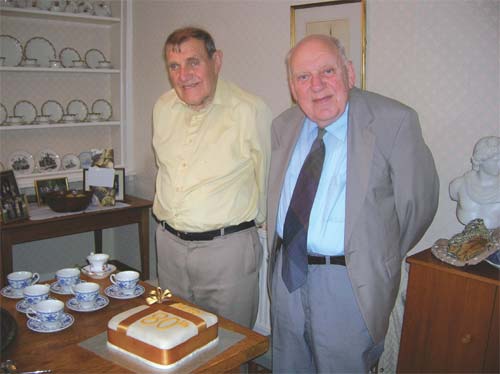 |
©Trowbridge Civic Society 2010
